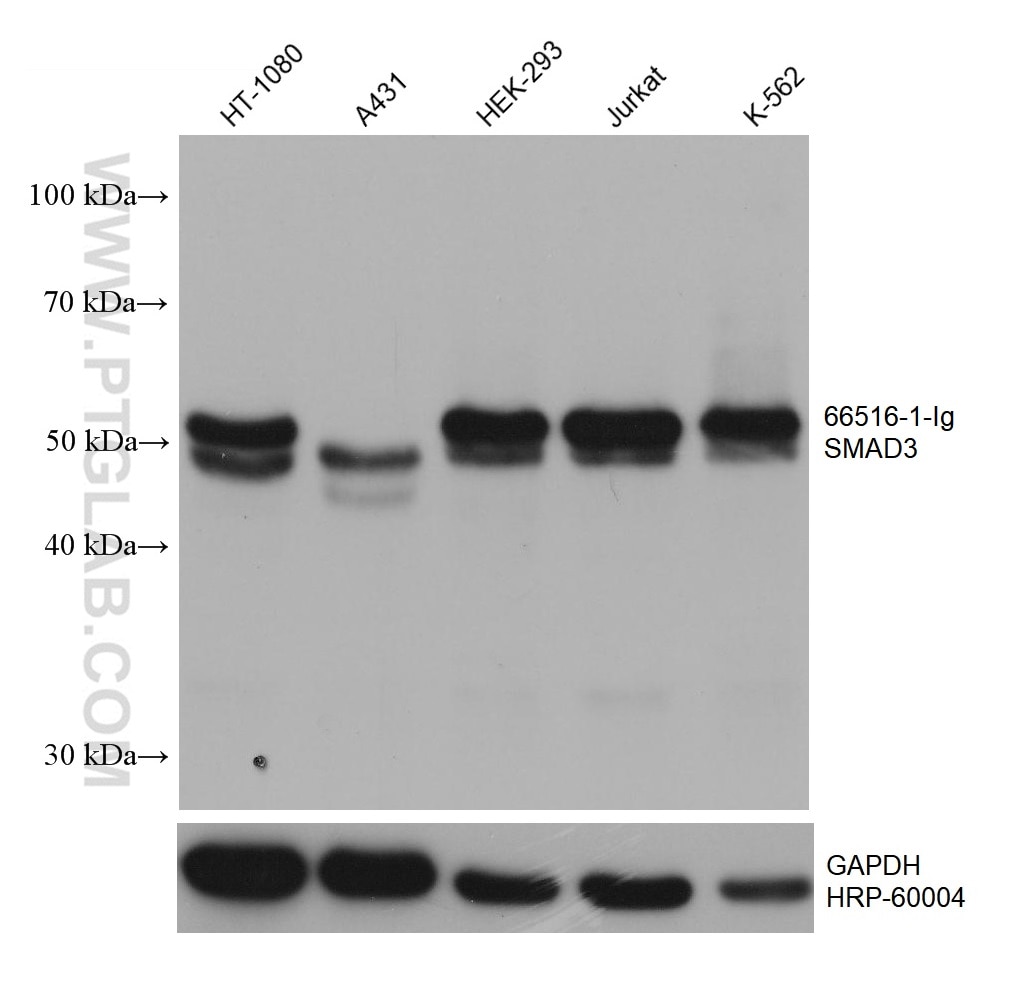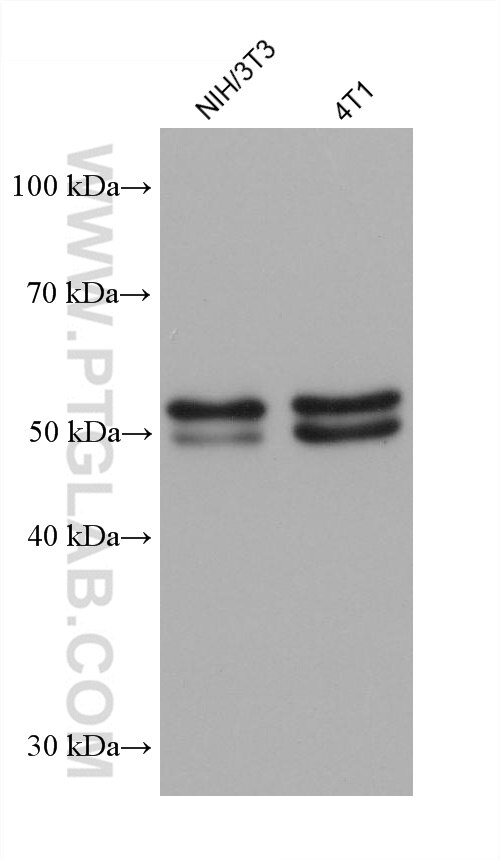Anticorps Monoclonal anti-SMAD3
SMAD3 Monoclonal Antibody for WB, ELISA
Hôte / Isotype
Mouse / IgG1
Réactivité testée
Humain, souris
Applications
WB, IHC, IF, CoIP, ELISA
Conjugaison
Non conjugué
CloneNo.
1F10B2
N° de cat : 66516-1-Ig
Synonymes
Galerie de données de validation
Applications testées
| Résultats positifs en WB | cellules HT-1080, cellules 4T1, cellules A431, cellules HEK-293, cellules Jurkat, cellules K-562, cellules NIH/3T3 |
Dilution recommandée
| Application | Dilution |
|---|---|
| Western Blot (WB) | WB : 1:2000-1:12000 |
| It is recommended that this reagent should be titrated in each testing system to obtain optimal results. | |
| Sample-dependent, check data in validation data gallery | |
Applications publiées
| WB | See 57 publications below |
| IHC | See 1 publications below |
| IF | See 5 publications below |
| CoIP | See 1 publications below |
Informations sur le produit
66516-1-Ig cible SMAD3 dans les applications de WB, IHC, IF, CoIP, ELISA et montre une réactivité avec des échantillons Humain, souris
| Réactivité | Humain, souris |
| Réactivité citée | Humain, souris |
| Hôte / Isotype | Mouse / IgG1 |
| Clonalité | Monoclonal |
| Type | Anticorps |
| Immunogène | Peptide |
| Nom complet | SMAD family member 3 |
| Masse moléculaire calculée | 48 kDa |
| Poids moléculaire observé | 55-60 kDa |
| Numéro d’acquisition GenBank | NM_005902 |
| Symbole du gène | SMAD3 |
| Identification du gène (NCBI) | 4088 |
| Conjugaison | Non conjugué |
| Forme | Liquide |
| Méthode de purification | Purification par protéine A |
| Tampon de stockage | PBS avec azoture de sodium à 0,02 % et glycérol à 50 % pH 7,3 |
| Conditions de stockage | Stocker à -20°C. Stable pendant un an après l'expédition. L'aliquotage n'est pas nécessaire pour le stockage à -20oC Les 20ul contiennent 0,1% de BSA. |
Informations générales
SMAD3, also named as hMAD 3 or Mad3, is a 425 amino acid protein, which contains one MH1 domain and one MH2 domain. SMAD3 localizes in the nucleus and cytoplasm. SMAD3 plays an essential role in development and maintenance of self-tolerance and is a critical mediator of the TGFB signaling pathway. SMAD3 is involved in TGFB dependent regulation of steroidogenesis and in T-cell response to TGFB.
Protocole
| Product Specific Protocols | |
|---|---|
| WB protocol for SMAD3 antibody 66516-1-Ig | Download protocol |
| Standard Protocols | |
|---|---|
| Click here to view our Standard Protocols |
Publications
| Species | Application | Title |
|---|---|---|
J Exp Clin Cancer Res ACTN1 promotes HNSCC tumorigenesis and cisplatin resistance by enhancing MYH9-dependent degradation of GSK-3β and integrin β1-mediated phosphorylation of FAK | ||
Drug Des Devel Ther Keloid Patient Plasma-Derived Exosomal hsa_circ_0020792 Promotes Normal Skin Fibroblasts Proliferation, Migration, and Fibrogenesis via Modulating miR-193a-5p and Activating TGF-β1/Smad2/3 Signaling | ||
Cell Chem Biol Substrate-dependent interaction of SPOP and RACK1 aggravates cardiac fibrosis following myocardial infarction | ||
Cell Mol Life Sci Macrophage Dectin-1 mediates Ang II renal injury through neutrophil migration and TGF-β1 secretion | ||
Oxid Med Cell Longev Smad7 Is Highly Expressed in Human Degenerative Discs and Participates in IL-1β-Induced Apoptosis of Rat AF Cells via the Mitochondria Pathway. | ||
Mol Ther Nucleic Acids Genetic or siRNA inhibition of MBD2 attenuates the UUO- and I/R-induced renal fibrosis via downregulation of EGR1. |



